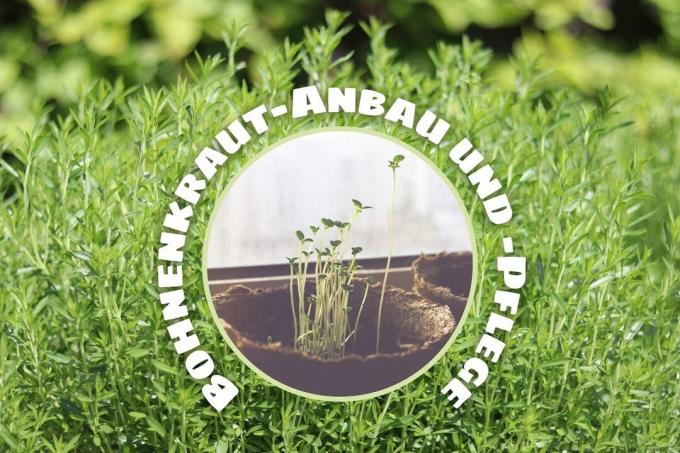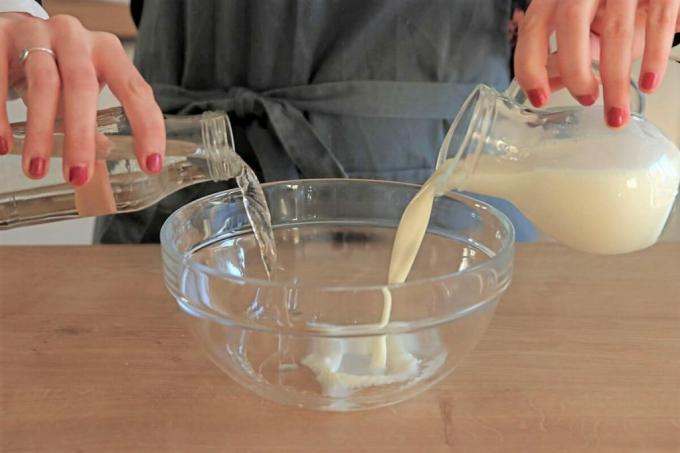
table of contents
- Location and soil
- Care instructions
- Watering and fertilizing
- Cut
- Overwinter
- Multiplication
- Harvest and storage
- Diseases and pests
- frequently asked Questions
Savory is a herb and culinary herb with a strong taste both fresh and dried. It can be used cooked, but also fresh with raw vegetables and salads. Read here how to grow savory properly.
In a nutshell
- annual summer savory (Satureja hortensis) and biennial to perennial winter or mountain savory (Satureja montana) are best known
- minor deviations in growth, cut and seasoning power
- no major differences in care
- Sowing takes place from April to May or in August (either in seed pots or outdoors)
- Direct planting of purchased young plants is also possible (planting distance: 30 x 30 centimeters)
Location and soil
When growing the savory, the location and the nature of the soil are particularly important. It loves warm, sheltered and sunny locations. The sun provides the special aroma. Ideally, it stands separately because it seeds itself and could affect other plants in terms of growth.

- Soil should be well drained and slightly calcareous
- with a pH between 5.7 and 7.2
- Summer savory loves light, nutrient-rich and humus-rich soil
- Mountain savory prefers poor, nutrient-poor, well-draining soil
- for growing on dense, loamy subsoil, improve permeability
- with pumice, quartz sand or zeolite
Care instructions
Below is a guide to properly caring for the savory after successfully growing it. This is how you water, fertilize, cut and overwinter Satureja properly.
Watering and fertilizing
The water requirement of this aromatic herb is rather low. Both species cope much better with drought than with wetness. Most of the time, the natural amounts of rain are completely sufficient. Additional watering should only be used if it is persistent and dry on particularly hot summer days. Savory in the pot needs to be watered more often, depending on the location. It is best when the top two centimeters of the substrate have dried off. Savory is also very frugal when it comes to nutritional requirements. The annual herb can be fertilized with a little compost in spring, the winter variant with Horn shavings.

Tip: Sometimes it can also be useful to enrich the soil with a little lime.
Cut
Summer savory
No complicated pruning is required to grow this type of savory. However, if you want to stimulate growth and leaf formation, pruning before flowering is a good idea. It is sufficient to shorten the stems by about ten centimeters. This also makes sense if the tips of the savory begin to tilt to the ground due to the heaviness. Towards the end of the season, the entire plant is cut down close to the ground.
Winter savory
- grows stronger and woodier than summer savory
- Regular cut therefore part of the maintenance
- best time to do this around April
- Cut the cabbage back to one or two hand's widths above the ground
- In addition, remove aged, damaged and frozen shoots
- Clean up dried leaves
- If necessary, cut again in autumn
- up to about ten centimeters above the ground
- Plant grows more branched and bushier
- Regular cutting prevents excessive lignification

Tip: Basically, you should be careful not to cut into the old wood. Should it still happen, the plants will need some time to recover.
Overwinter
Wintering is also part of the care. Summer savory has to be grown or grown anew every year. sowing. The winter savory is considered hardy, but should be protected from severe frost, especially in rough locations. To do this, it is sufficient to cover the herb with fir twigs, fleece or leaves. Specimens in the pot need a little more protection. Without it, the bale could freeze through very quickly. To prevent this from happening, put the pot in a bright and cool, but frost-free, room. This can be a shed, a garage or the stairwell.
Multiplication
Three different methods are available to you to propagate the savory:
- sowing
- Cuttings
- division
Sowing instructions
Sowing is particularly useful for summer savory. The seeds used should be as fresh as possible, otherwise it can happen that they germinate only sparsely or not at all. This applies to both own and purchased seeds. Depending on the weather, savory is sown on the spot from April to June. Alternatively, you can also use it in seed trays.

- first loosen the soil thoroughly
- Mix in some compost if necessary
- sow in rows, minimum distance approx. 25 cm
- Draw small grooves for orientation
- Spread the seeds in it and press down lightly
- Seeds belong to the light germs
- therefore cover only lightly with sand or earth
- Pour carefully and keep moderately moist
- Germination temperatures between 15 and 20 degrees
- Germination time two to four weeks
- Prick as soon as the first leaves appear
- Keep a distance of 20-30 cm when planting
Tip: Since the seeds are very fine, it can be useful to use a small sieve to distribute them. In order to be able to harvest for as long as possible, it is also advisable to plant subsequent seeds about every two weeks.
About cuttings
- ideal type of propagation for winter savory
- best time in July and August
- cut one or more half lignified cuttings
- about eight to ten inches long
- first remove the bottom leaves
- then place the cuttings in a glass of water to root
- then bring it to a bright and warm place
- Root formation usually after a few days
- Finally, plant rooted cuttings in small pots
- Hibernate young plants indoors for the first year
- not outside until the following spring
Tip: It is generally advisable to multiply the perennial herb every two to three years, as it loses its vigor over time. Incidentally, summer savory can also be propagated using cuttings.
division
The best time to split is in spring. This is done by digging up the plant in question and dividing it into two or more parts with a spade or a sharp knife. Each of these parts should be at least the size of a fist. Now they are replanted individually at their final location and the whole thing is well watered.
Harvest and storage
In general, winter savory can be harvested almost all year round, summer savory from summer to autumn. As a general rule, you should harvest savory after you grow it, before and during flowering. The essential oil content is before flowering highest and the herb accordingly most aromatic. The aroma already fades during flowering.

After harvest, the herb can be used fresh or dried for longer storage. By the dry if no aroma is lost, on the contrary, it becomes even more intense. Once it is completely dry, it can be stored in lockable jars in a dark, dry place for about 1 year store.
Tip: To dry, bundle branches of the savory and hang them in a place that is airy and protected from the sun. Alternatively, you can also use an oven or dehydrator. In any case, when drying savory, the temperature should NOT exceed 40 degrees Celsius.
Diseases and pests
Wrong mildew
It occurs mainly on annual plants. The white spots on the underside of the leaves, which spreads further, are characteristic. Infested parts of the plant should be removed and disposed of immediately and generously. help promise Lye made from whey and water (1: 1) or from milk and water (1:5). The plants are sprayed several times with it.

Gray mold
Mainly affects already weakened plants. First, there are glassy, sallow spots on the leaves and flowers. Later, gray moldy lawn covers the plants, leaves and shoots die off. Here it is Remove the entire plant advisable, because the mycelium survives on the plant.
Cicadas
From around mid-May, white, gray to silver-colored, shiny puncture points can be seen. The leaves look speckled, the green color is lost more and more, necroses develop. A radical post-harvest cut can decimate an infestation. Otherwise, the Use of neem supplements at.
Black bean aphid
It sits on the plants in large black colonies. In addition, there is honeydew on which black fungi can settle. The lice can also transmit the bean yellow mosaic virus. Are suitable for combating natural predators like ladybugs and lacewings as well Neem oil and rapeseed oil preparations.
frequently asked Questions
Yes, if you want to grow savory, you should be careful not to plant it where it was or where it was. to plant it there again after four years at the earliest. This is due to the intolerance of this plant with itself.
The creeping mountain savory, a smaller ornamental shape, is particularly suitable for this. It grows flat and pillow-like, its leaves are smaller, it has a good aroma and, thanks to its bright white flowers, is also pretty to look at.
Yes, that is possible without any problems, the taste is then only slightly milder. The summer savory flowers from July and the mountain savory between August and October.

